Dogs
How Puppies Can Eat Adult Dog Food Safely
Fulfilling a puppy's nutritional needs with adult dog food requires careful consideration – find out why timing is crucial.
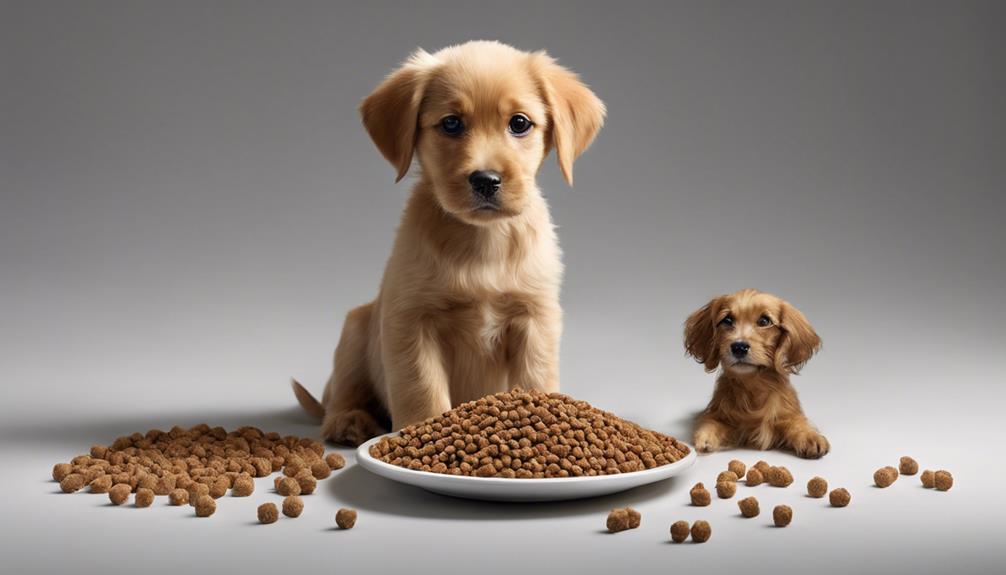
When transitioning puppies to adult dog food, it's crucial to consider their unique nutritional requirements. Puppies need increased levels of vital nutrients like protein, calcium, and phosphorus, which are typically present in puppy-specific formulas. Prematurely switching them to adult food can result in deficiencies that can hinder their growth and development. By slowly transitioning them under the guidance of a professional, we ensure that they receive the necessary nutrients for healthy growth. Having a good grasp of the timing and essential components is essential for promoting their overall well-being.
Key Takeaways
- Gradually transition puppies over 5 to 7 days to prevent digestive upsets.
- Consult a veterinarian to determine the right timing for the switch based on breed and size.
- Monitor puppies for signs of deficiencies or digestive issues after transitioning.
- Ensure adult dog food meets growth and development needs with adequate nutrients.
- Look for appropriate levels of protein, fat, and essential nutrients for overall puppy health.
Age Considerations for Feeding Puppies
When considering the age for feeding puppies, it's important to establish the suitable timing for shifting them to adult dog food based on their breed size and growth stage.
Puppies can safely shift to adult food once they reach maturity, typically between 9 to 15 months, depending on their breed size. Smaller breeds may make the change sooner, while larger breeds such as giants may not shift until they're around 24 months old.
Consulting a veterinarian for guidance on the appropriate age to switch your puppy to adult dog food is critical for their development. Timing the change based on your puppy's growth stage ensures they receive the necessary nutrients for their specific life stage.
This careful approach to switching to adult food at the right age supports optimal growth and overall health for your furry companion.
Nutritional Needs of Growing Puppies
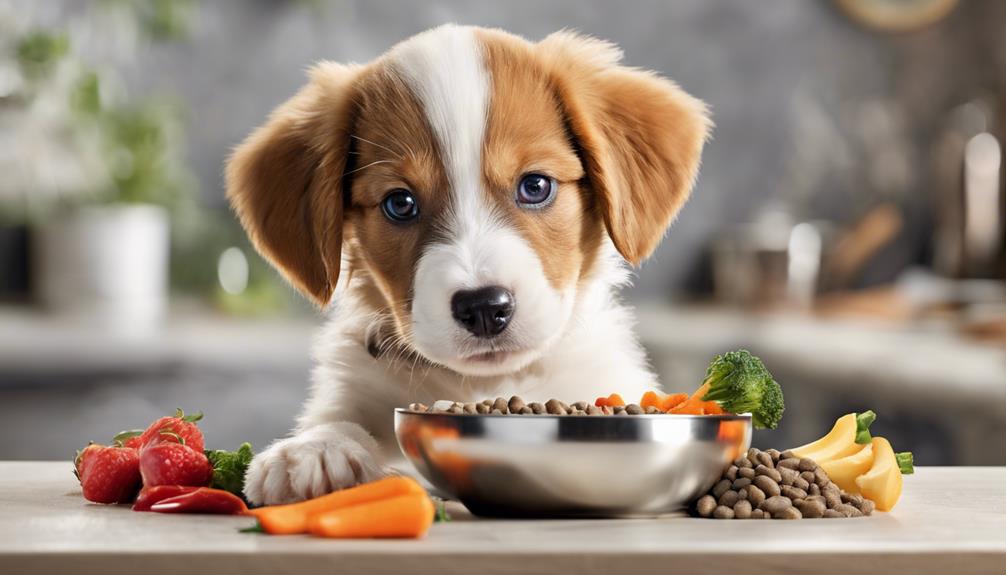
As puppies mature, their nutritional requirements significantly vary from those of adult dogs, necessitating higher levels of vital nutrients like protein, calcium, and phosphorus for proper development. Puppies have specific calorie ratios, protein content, and requirements for calcium and phosphorous that are vital for their healthy growth and development. Unlike adult dog foods, which may lack these vital nutrients in the appropriate amounts, puppy formulas are designed to provide the necessary building blocks for their growing bodies.
Feeding puppies adult dog food can lead to nutritional deficiencies that may impact their bone, muscle, and organ development. To make sure puppies receive the right balance of nutrients, it's important to follow veterinary guidance when selecting their diet. Shifting puppies to adult dog food should be a gradual process done under professional supervision to guarantee they continue to receive the appropriate levels of vital nutrients for their growth. By meeting their specific nutritional needs during this critical stage, we can support puppies in reaching their full potential.
Transitioning Puppies to Adult Dog Food
Shifting puppies to adult dog food requires a gradual introduction over 5 to 7 days to prevent gastrointestinal issues and guarantee a smooth adjustment. It's important to make this shift slowly to avoid upsetting their stomachs. Here are some essential points to keep in mind when moving puppies to adult dog food:
- Small breeds can switch to adult dog food at 9 to 12 months, while larger breeds should make the change at 18 months.
- Gradual introduction of adult food over 5 to 7 days helps prevent gastrointestinal issues in puppies.
- Sudden changes in food may cause diarrhea, vomiting, and decreased appetite, so a slow adjustment is key.
- Puppies with food allergies or sensitive stomachs may need a longer adaptation period to adult dog food.
- Consulting a veterinarian for guidance on transitioning your puppy to adult dog food is recommended for a smooth adjustment.
Risks of Feeding Puppies Adult Dog Food
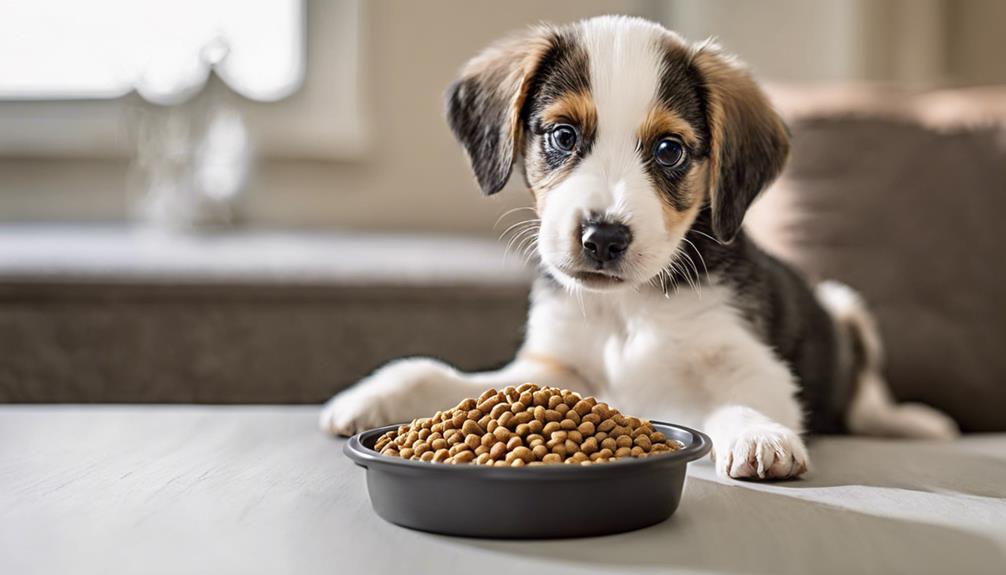
To safeguard the health and development of puppies, it's important to be cautious of the risks associated with feeding them adult dog food. Puppies have different nutritional needs than adult dogs, requiring specific nutrients for their growth and reproduction.
When puppies eat adult dog food, they may face serious health issues due to the lack of essential components necessary for their development. Adult dog food is formulated to meet the needs of fully grown dogs, potentially leading to nutritional deficiencies in puppies.
Specifically, the high levels of calcium and phosphorus in adult dog food can harm joint health and impact proper bone development in growing puppies. It's essential to provide puppies with a diet that's complete and balanced for their stage of life to ensure they receive important nutrients like omega-3 fatty acids essential for a healthy puppy.
Feeding puppies adult dog food can result in developmental issues and long-term health problems, emphasizing the importance of catering to their specific dietary requirements.
Safe Practices for Feeding Puppies
Implementing gradual dietary changes is crucial for ensuring the smooth adjustment of puppies to adult dog food, preventing potential digestive issues. When switching your puppy to adult dog food, consider the following safe practices:
- Gradually Shift: Shift puppies over 5 to 7 days to avoid digestive upset.
- Consult Vet: Seek guidance from a veterinarian to determine the right time based on breed and size.
- Monitor Health: Watch for signs of nutritional deficiencies or digestive issues post-shift.
- Ensure Nutrient Balance: Confirm that adult dog food supports growth and development needs.
- Consider Nutrients: Look for adequate levels of protein, fat, and essential nutrients for overall health.
Frequently Asked Questions
Is It OK for a Puppy to Eat Adult Dog Food?
It's not recommended for puppies to eat adult dog food as their nutritional needs differ. Puppies require specific nutrients for growth and development, which adult dog food may lack.
Consulting a vet before switching a puppy to adult food is essential for ensuring proper nutrition. Inappropriate feeding can lead to health issues due to potential deficiencies.
Opting for puppy food is important for their healthy growth.
What Age Can Puppies Go Onto Adult Food?
Puppies can move to adult dog food between 9 and 15 months of age, depending on breed size. Smaller breeds may switch earlier, while larger breeds might wait until 24 months. Consult a vet for guidance on the right timing.
The change should match your puppy's growth stage. It's important to guarantee a smooth shift to adult food to meet their changing nutritional needs.
What if I Accidentally Gave My Dog Puppy Food?
If we mistakenly provide our dog puppy food, it's not harmful in the short term but might lack essential nutrients for adult dogs. It's best to consult a vet for guidance to make sure our dog's nutrition is balanced.
Regularly monitoring our dog's health and making diet adjustments as necessary is key. Remember, what our furry friends eat impacts their overall well-being, so staying informed and proactive is crucial for their health.
How Old Till Puppies Can Eat Dog Food?
Puppies can typically begin consuming adult dog food between 9 to 15 months of age. Smaller breeds may shift earlier, while larger breeds might change later.
It's important to consult a veterinarian for guidance on the best timing to switch your puppy to adult food. The change should align with your puppy's growth stage and nutritional needs.
Timing the shift properly is vital for your puppy's health and development.
Can Puppies Safely Eat Peanut Butter Flavored Treats Like Reese’s Pieces?
Yes, dogs should avoid Reese’s Pieces and other peanut butter treats that contain certain ingredients like xylitol, as they can cause serious health risks for dogs. It’s best to stick to dog-friendly peanut butter treats to ensure their safety and prevent any potential harm.
– Can Puppies Safely Transition to BJ Raw Dog Food from Adult Dog Food?
Yes, puppies can safely transition to BJ Raw Dog Food from adult dog food. This nutritious raw dog food choice provides essential nutrients for growing pups. It’s important to gradually introduce the new food and monitor their weight and digestion to ensure a smooth transition.
Conclusion
To sum up, it's crucial to take into account the age and nutritional needs of puppies when switching them to adult dog food. One noteworthy statistic to mention is that puppies need up to twice as much protein and fat in their diet compared to adult dogs to support their growth and development.
By following safe practices and monitoring their health, puppies can safely consume adult dog food to make certain they thrive.
As our Editor-in-Chief, James plays a pivotal role in ensuring the quality and integrity of our content. With a keen eye for detail and a passion for storytelling, James oversees the editorial process here at A Place for Animals. With years of experience in content editing, James ensures that every piece of content meets our high standards of accuracy and clarity. Under James’ guidance, you can rest assured that the content you read is informative and impeccably crafted.
Dogs
Top 5 Cinderella-Inspired Cat Names for Royal Pets
Step into a world of enchantment with the top 5 Cinderella-inspired cat names starting with the letter 'S', fit for royal feline companions!
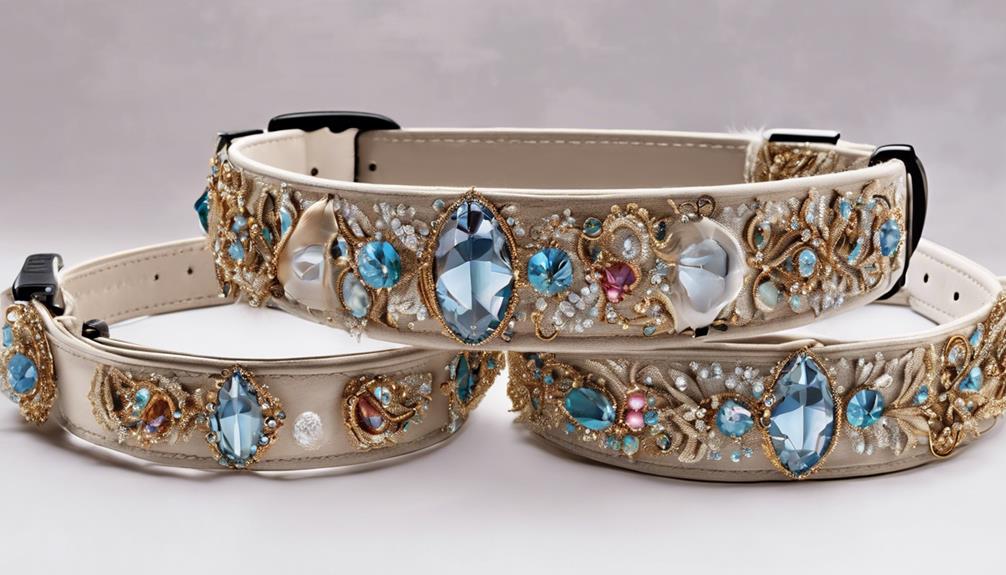
When considering names for royal feline companions inspired by Cinderella, the top five choices include Cinder, Ella, Prince Charming, Fairy Godmother, and Glass Slipper. Each name embodies regal grace, elegance, and a touch of fairy tale charm, reflecting enchantment and sophistication. Cinder symbolizes a transformative journey, Ella defines grace and elegance, Prince Charming exudes gallantry and sophistication, Fairy Godmother adds a magical touch, and Glass Slipper represents destiny fulfilled through love. These names bring a regal aura to your cat's identity, signaling nobility and charm. A royal touch awaits your feline friend with these Cinderella-inspired names!
Key Takeaways
- Cinder: embodies regal grace and charm, inspired by Cinderella's tale.
- Ella: defines grace and elegance, perfect for princess-like cats.
- Prince Charming: exudes nobility and charm, ideal for a dashing cat.
- Fairy Godmother: adds whimsy and enchantment, capturing a magical essence.
- Glass Slipper: symbolizes elegance and destiny, perfect for white cats with poise.
Cinder – A Name Fit for Royalty
Elegantly embodying regal grace and charm, our feline companion can aptly be deemed Cinder – a name inspired by the enchanting tale of Cinderella. When considering royal cat names, Cinder stands out as a classic choice that exudes fairy tale charm. This name not only pays homage to the iconic glass slipper but also symbolizes the transformative journey from rags to riches, mirroring Cinderella's story.
Choosing Cinder as a cat name for your royal pet brings a touch of magic and fantasy into your home. The name carries a sense of elegance and sophistication, fitting for a regal feline friend. Just like Cinderella captivated hearts with her grace and charm, your cat named Cinder can enchant all who encounter them. Embracing this timeless and classic name adds a touch of whimsy and enchantment to your furry companion, making them truly stand out as royalty among pets.
Ella – Graceful and Elegant Choice
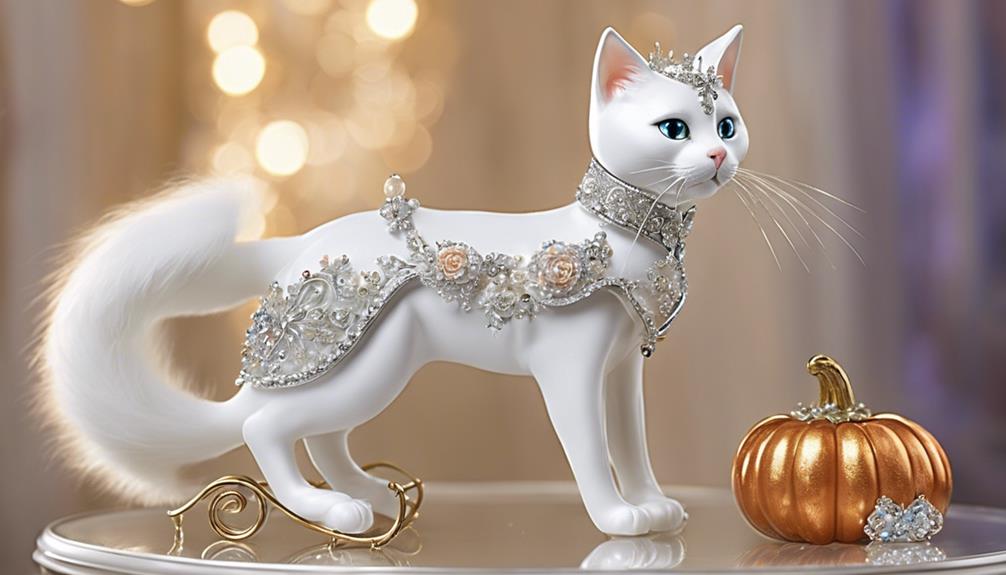
Grace and elegance define 'Ella' as a timeless and charming choice for your royal feline companion. This name exudes a sense of royalty and sophistication, perfect for a princess-like cat that embodies grace and elegance in every movement.
Just like Cinderella, 'Ella' is a name that resonates with a regal aura, making it an ideal pick for cat owners seeking a touch of fairy tale magic in their pet's identity. The simplicity and beauty of 'Ella' encapsulate the essence of a graceful and elegant companion, reflecting the poise and charm befitting a royal cat.
Choosing 'Ella' for your feline friend not only honors the beloved princess but also adds a sense of refinement and sophistication to their character. Embrace the royal heritage and noble qualities that 'Ella' brings, elevating your cat's status to that of a true princess in your household.
Prince Charming – Perfect for a Dashing Cat
A cat named Prince Charming embodies a regal and dashing presence that captures the essence of nobility and grace. This royal kitty exudes charm and elegance, making it a perfect choice for feline companions who deserve a name that reflects their majestic nature.
Prince Charming isn't just a name; it symbolizes the virtues of gallantry and sophistication, aligning perfectly with the image of a cat with a princely demeanor. The significance of the name goes beyond mere words; it signifies nobility and grace, just like a crown adorning the head of a king.
Choosing Prince Charming as the moniker for your furry friend adds a touch of fairy tale magic to their identity, elevating them to a level of enchantment and regality that suits their distinguished character. So, if you seek a name that conveys both elegance and nobility, consider Prince Charming for your beloved feline companion.
Fairy Godmother – Adding a Magical Touch
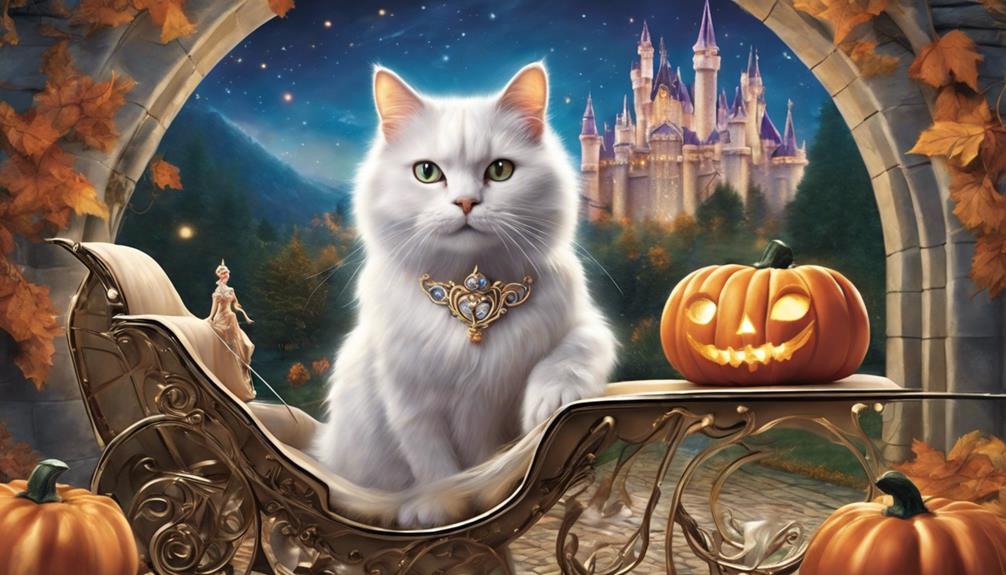
Embracing the enchanting allure of a magical touch, a Fairy Godmother-inspired name for your feline companion can infuse their persona with whimsy and charm.
The Fairy Godmother, known for her transformative magic in the Cinderella story, brings a sense of enchantment to any royal pet lucky enough to bear her name. Names like 'Fae' or 'Glimmer' capture the mystical essence associated with the fairy godmother, adding a touch of fantasy to your cat's identity.
Imagine your regal pet embodying the same spellbinding abilities as the enchanting Fairy Godmother. Choosing a name like 'Enchanta' or 'Charisma' can evoke the transformative magic she wields, creating a sense of wonder and elegance around your furry friend.
Glass Slipper – Symbol of Elegance
Infusing your feline companion's persona with elegance and charm, the Glass Slipper serves as a symbolic representation of grace and enchantment in the Cinderella story. This magical shoe, with its ability to fit only Cinderella's foot, signifies not just a perfect fit but also destiny fulfilled through love.
For a white cat exuding regal poise and sophistication, 'Glass Slipper' could be the perfect name, embodying the essence of royalty and elegance. Just like in the fairy tale, where the glass slipper is the key to identifying Cinderella as the true princess, naming your royal pet after this iconic symbol means capturing the enchanting and magical aura of the Cinderella tale.
The Glass Slipper symbolizes the transformative power of love and destiny, making it an ideal choice for a cat that exudes grace and charm. So, if you have a white cat that embodies elegance, consider 'Glass Slipper' as the perfect regal name.
Frequently Asked Questions
What Is a Royal Name for a Cat?
We believe a royal name for a cat embodies elegance and nobility, often inspired by monarchs, historical figures, or fictional characters. Such names add sophistication to a pet's identity, creating a regal aura.
What Cats Are Royal?
We believe that various cat breeds can be considered royal based on their regal appearance, demeanor, or historical associations. Some feline companions of monarchs or nobles receive special treatment, titles, and roles in royal households.
What Disney Name Should I Name My Cat?
We should name our cat after a beloved Disney character! It's a tough decision, but Cinderella, Gus-Gus, Anastasia, Jaq, or Fairy Godmother are all enchanting choices for our royal feline friend.
What Are Disney Cats Called?
We call them Disney cats, those charismatic felines that weave mischief and charm into our beloved stories. Whether heroes or villains, they captivate us with their antics, adding depth and whimsy to the tales we adore.
Conclusion
So there you have it, the top 5 Cinderella-inspired cat names fit for your royal feline companion. Whether you choose Cinder, Ella, Prince Charming, Fairy Godmother, or Glass Slipper, your cat will surely feel like a true prince or princess.
These names not only capture the essence of the beloved fairy tale, but also add a touch of elegance and magic to your pet's identity. Choose wisely and watch your cat reign supreme in their kingdom!
As our Editor-in-Chief, James plays a pivotal role in ensuring the quality and integrity of our content. With a keen eye for detail and a passion for storytelling, James oversees the editorial process here at A Place for Animals. With years of experience in content editing, James ensures that every piece of content meets our high standards of accuracy and clarity. Under James’ guidance, you can rest assured that the content you read is informative and impeccably crafted.
Dogs
Understanding Cordyline Toxicity in Dogs
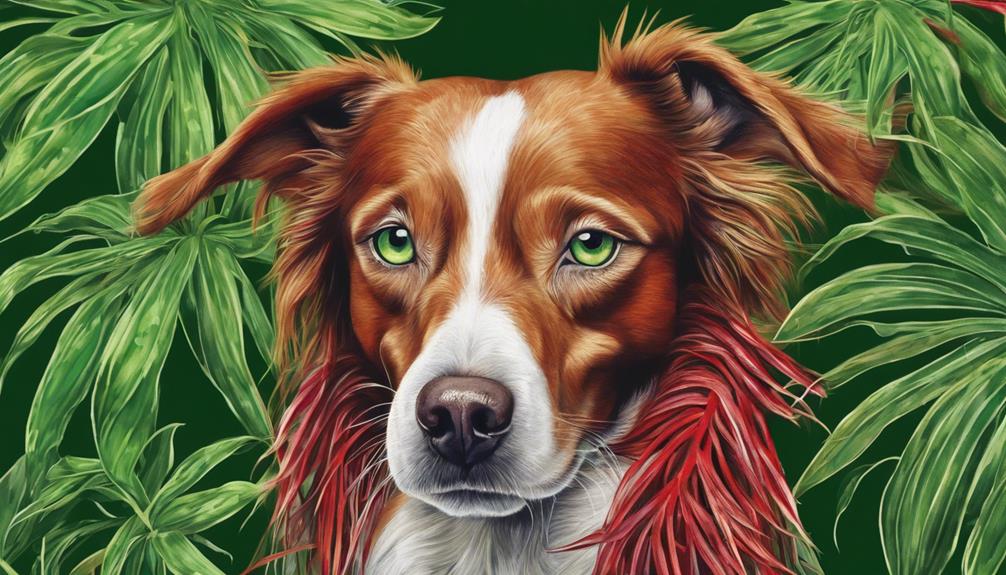
Cordyline plants, like Ti or Hawaiian Ti, are dangerous for dogs due to toxic compounds such as saponins found in all parts. Symptoms of ingestion include vomiting, weakness, and dilated pupils. If toxicity is suspected, induce vomiting, administer activated charcoal, and seek prompt veterinary care. Diagnosing poisoning involves physical exams, tests, and x-rays. Treatments include medication, fluid therapy, and close monitoring. Berries, leaves, and roots carry varying poison levels. Keep pets away from these plants. Consult a vet immediately if ingestion occurs. Veterinary care is essential for managing cordyline toxicity in dogs effectively. Discover more about protecting your furry friends.
Key Takeaways
- Cordyline plant is toxic to dogs due to saponins in all parts.
- Symptoms include vomiting, weakness, and dilated pupils.
- Emergency actions include inducing vomiting and seeking vet care.
- Prompt veterinary diagnosis and treatment are crucial.
- Keep Cordyline plants out of reach to prevent toxicity.
Cordyline Plant Overview
Investigating the harmful nature of the Cordyline plant reveals its potential dangers to dogs. The Cordyline plant, also known as Ti plant or Hawaiian Ti, is a common decorative plant found in many households and gardens. This plant contains toxic compounds, such as saponins, in all its parts, including the berries and roots. These compounds can be harmful to our canine companions if ingested. Dogs may experience symptoms like loss of muscle control, weakness, and gastrointestinal issues if they consume any part of the Cordyline plant. It's vital for pet owners to be aware of the potential dangers this plant poses to their furry friends.
As responsible pet owners, it's important to make sure that our dogs don't have access to the Cordyline plant to prevent accidental ingestion. By being vigilant and keeping our pets away from this toxic plant, we can protect them from experiencing harmful effects on their health. Remember, prevention is essential when it comes to keeping our furry friends safe from toxic plants like the Cordyline.
Common Symptoms of Toxicity

What're the common symptoms of toxicity in dogs exposed to cordyline plants? Dogs can show various signs of toxicity if they ingest parts of the cordyline plant. Some common symptoms include vomiting, weakness, loss of muscle control, and dilated pupils.
These signs can occur immediately or may be delayed, depending on the amount ingested. The toxic compounds present in cordyline, such as saponins and glycosides, are responsible for these harmful effects on dogs. Saponins and glycosides can lead to serious health issues in our canine friends, so it's essential to be aware of these symptoms if your dog has been near or ingested a cordyline plant.
If you notice any of these signs or suspect cordyline toxicity, seek immediate veterinary attention. Remember, prompt diagnosis and proper treatment are crucial for the recovery of dogs exposed to cordyline toxicity. Keep a close eye on your furry companion and act promptly if you suspect any issues related to plants toxic to dogs.
Emergency Actions to Take
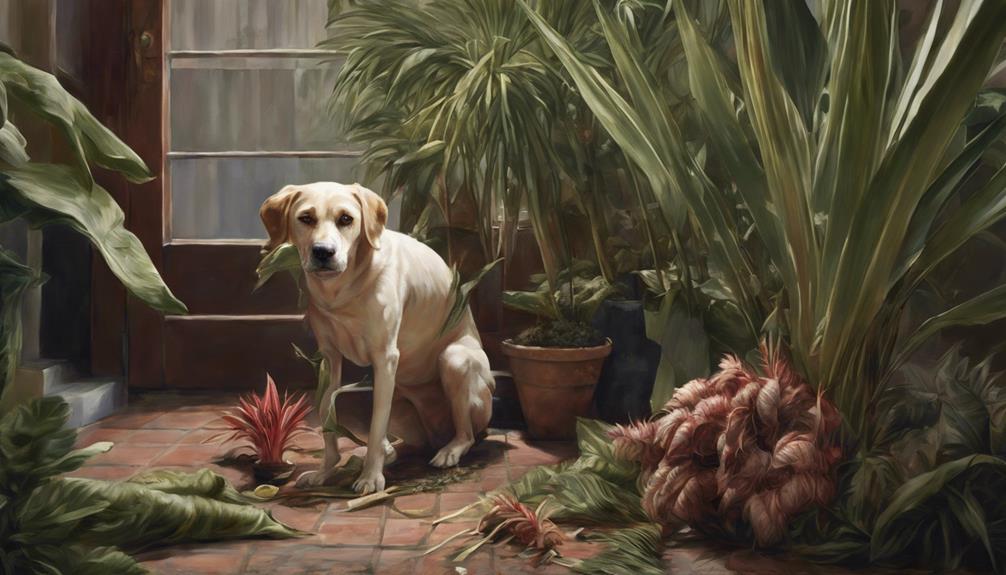
After observing symptoms of cordyline toxicity in dogs, immediate actions can include inducing vomiting to expel the toxic plant material. Administering activated charcoal can help prevent further absorption of toxins. It's important to seek veterinary care promptly. Intravenous fluids might be necessary to flush out the toxins and rehydrate your dog. These steps can aid in the speedy recovery of your pet.
When dealing with a potential cordyline poisoning, remember that quick action is key. Inducing vomiting and giving activated charcoal can limit the harm caused by the toxins. Ensuring your dog receives proper hydration through intravenous fluids will support their healing process. By acting swiftly and decisively, you can increase the chances of a positive outcome for your furry friend. Remember, in emergencies like these, always consult a professional for guidance.
Diagnosing Cordyline Poisoning

To diagnose cordyline poisoning in dogs, veterinarians conduct a thorough physical examination to assess the dog's health parameters. Diagnostic tests such as urine, stool samples, and blood tests may be necessary to confirm cordyline ingestion. X-ray imaging can help detect any tummy blockages caused by ingested plant material in cordyline poisoning cases. Symptoms of cordyline poisoning in dogs may include vomiting blood and weakness, indicating the severity of the toxicity. Here is a table summarizing the diagnostic methods used in cordyline poisoning cases:
| Diagnostic Method | Description |
|---|---|
| Physical Examination | Assess dog's overall health and look for symptoms. |
| Urine Sample Analysis | Check for presence of toxins from ingested plants. |
| Blood Tests | Evaluate blood parameters for signs of toxicity. |
These methods help veterinarians confirm cordyline ingestion and determine the appropriate treatment for the affected dog.
Treatment Options Available

When a dog ingests cordyline and shows symptoms of toxicity, treatment options include:
- Giving medication to counteract the poison
- Providing fluid therapy to flush out toxins and rehydrate the pet
- Closely monitoring essential signs to guarantee improvement
These steps are pivotal in managing the effects of cordyline poisoning and supporting the dog's recovery.
It's essential to seek immediate veterinary care for proper diagnosis and treatment to increase the chances of a successful outcome.
Medication for Poisoning
In treating cordyline toxicity in dogs, activated charcoal may be administered to prevent further absorption of toxins. This helps to bind the toxins in the stomach and intestines, reducing their harmful effects.
Additionally, intravenous (IV) fluids are often given to dogs who've ingested cordyline. These fluids help flush out the toxins from the body and keep the dog hydrated.
Antibiotics may also be prescribed to prevent any infections that could arise from cordyline poisoning.
Moreover, medications like antacids or omeprazole can be used to alleviate stomach issues that may occur due to cordyline toxicity.
Fluid Therapy Options
Utilizing intravenous fluid therapy plays an essential role in supporting dogs affected by cordyline toxicity, aiding in toxin elimination and rehydration. When dealing with cordyline poisoning, administering IV fluids is essential to help flush out the toxins from the body and maintain proper hydration levels. IV fluids not only support organ function but also assist in eliminating toxic substances effectively. By providing fluids intravenously, veterinarians can precisely control the volume and rate of fluid delivery, ensuring the dog receives the necessary support for recovery. Proper fluid therapy helps in maintaining blood pressure, electrolyte balance, and hydration levels, all of which are crucial in the treatment of cordyline toxicity.
| Fluid Therapy Benefits |
|---|
| Supports toxin elimination |
| Aids in rehydration |
| Maintains organ function |
| Controls fluid volume and rate |
| Essential for recovery process |
Monitoring Vital Signs
Evaluating essential signs in dogs affected by cordyline toxicity is pivotal for determining the severity of the poisoning and deciding necessary treatment interventions. Monitoring critical signs such as heart rate, respiratory rate, and temperature is essential in gauging the dog's condition.
Changes in these parameters, along with symptoms like dilated pupils and loss of muscle control, can indicate the seriousness of the toxicity. Veterinarians rely on these signs to measure the effectiveness of treatments and the overall well-being of the dog.
Close observation of important signs guides the treatment plan, ensuring appropriate actions are taken for the dog's recovery. Any abnormalities in essential signs may prompt additional interventions or adjustments to the treatment protocol, emphasizing the importance of continuous monitoring for the dog's health.
Preventing Cordyline Ingestion

To prevent cordyline ingestion in dogs, it's essential to keep these plants out of their reach. Educate yourself on the symptoms of cordyline toxicity to recognize any potential issues early on.
Regularly inspect your surroundings to guarantee the safety of your pets and promptly seek veterinary care if ingestion is suspected.
Dangers of Ingestion
To prevent cordyline ingestion in dogs, it is important for pet owners to be aware of the toxic nature of all parts of the plant and take necessary precautions. Dogs can suffer from cordyline poisoning if they ingest any part of the plant, such as the berries, leaves, or roots. To highlight the dangers of ingestion, consider the following table:
| Part of the Plant | Concentration of Poison |
|---|---|
| Berries | High |
| Leaves | Moderate |
| Roots | High |
Understanding the toxicity levels in different parts of the cordyline plant can help pet owners recognize the seriousness of ingestion. By being informed and vigilant, we can protect our furry friends from the harmful effects of cordyline poisoning.
Safety Measures for Pets
Let's take the necessary steps to safeguard our pets by implementing practical safety measures to prevent cordyline ingestion.
To guarantee your furry friends' well-being, keep cordyline fruticosa plants out of their reach.
Educate yourself on the toxicity levels of these plants for pets.
Consider getting pet insurance to cover emergencies like vomiting blood due to cordyline ingestion.
If you suspect your pet has ingested cordyline, seek veterinary care promptly.
Regularly check your surroundings for cordyline plants to maintain a safe environment for your pets.
Importance of Veterinary Consultation
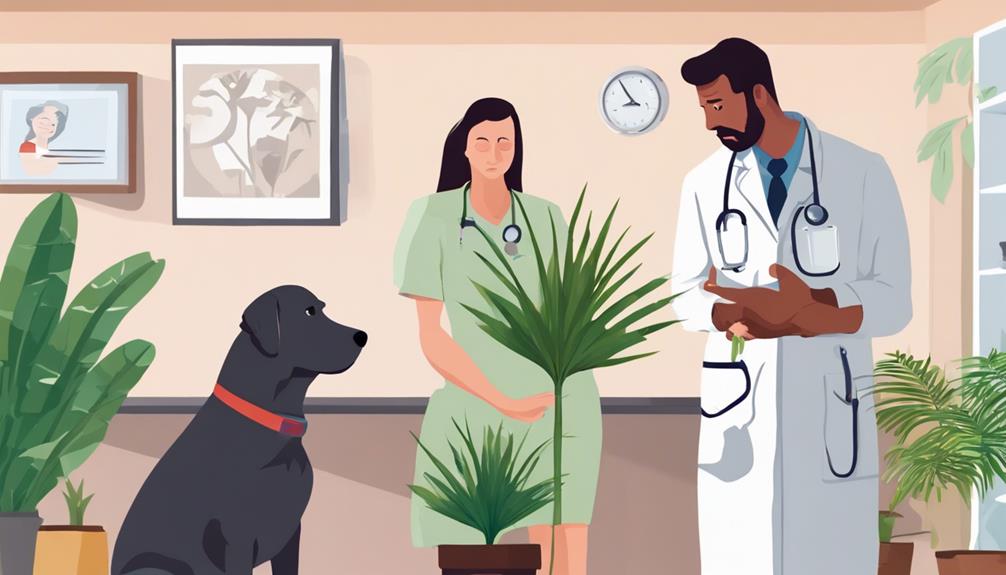
Seeking veterinary consultation promptly is essential when dealing with suspected cordyline toxicity in dogs. When it comes to your furry friend's health, timely action can make a significant difference. Here's why veterinary consultation is pivotal:
- Professional Assessment: Veterinarians have the expertise to evaluate the severity of the situation. They can determine the best course of action to help your dog recover.
- Tailored Treatment: Through veterinary consultation, your pet can receive personalized care. This tailored approach can address specific symptoms and mitigate the effects of cordyline toxicity.
- Prevention of Complications: Acting quickly by consulting a veterinarian can prevent the development of serious complications. Immediate intervention increases the likelihood of a successful recovery for your canine companion.
Frequently Asked Questions
Can Dogs Chew on Ti Leaves?
Yes, dogs shouldn't chew on ti leaves as they're toxic to them. Ingesting ti leaves can cause symptoms like vomiting, diarrhea, and abdominal pain in dogs. The toxic compounds in ti leaves, such as saponins, can lead to serious health issues.
If you suspect your dog has chewed on ti leaves, seek veterinary care immediately for evaluation and treatment. Keep ti plants out of reach of pets to prevent accidental ingestion and toxicity.
Is Cordyline Red Sister Toxic?
Yes, Cordyline Red Sister is toxic to dogs due to saponins present in all parts of the plant. Ingestion can cause vomiting, diarrhea, weakness, and loss of muscle control in dogs. The berries and roots are especially harmful, containing concentrated poison.
Immediate veterinary care is essential if ingestion occurs to avoid severe complications. Treatments may involve induced vomiting, activated charcoal, IV fluids, and organ failure medication.
Is Cordyline Toxic to Humans?
Yes, cordyline plants are harmful to humans. Ingesting parts of the cordyline plant can cause mild symptoms like stomach upset in humans.
The toxic compounds in cordyline affect humans differently than they do dogs. It's important for pet owners to know about cordyline toxicity specifically concerning their dogs.
While cordyline toxicity is a concern for pets, it's not a significant health issue for humans.
Are Cabbage Palms Poisonous to Dogs?
Cabbage palms, or Cordyline plants, are toxic to dogs. Ingesting any part of the plant can cause symptoms like weakness and muscle control loss. Saponins and glycosides are the compounds responsible for this toxicity.
Immediate veterinary attention is vital if ingestion occurs. Symptoms may include vomiting blood, weakness, and abdominal pain. It's important to keep these plants away from pets to prevent any accidental ingestion and potential harm.
Conclusion
To wrap up, it's vital to keep cordyline plants away from your furry friends to prevent potential toxicity. If ingestion occurs, seek immediate veterinary assistance.
Remember, the consequences of cordyline poisoning can be severe, so it's important to take preventative measures seriously. Let's guarantee our pets stay safe and healthy by being vigilant about the plants they come into contact with.
After all, a healthy pet is a happy pet!
Dana is our Lead Content Writer, bringing a wealth of knowledge and expertise to our team. With a background deeply rooted in animal studies and a profound love for all creatures, Dana is dedicated to crafting engaging and informative content that resonates with our audience. With Dana at the helm, you can trust that our content is accurate and engaging, catering to the diverse interests of animal enthusiasts everywhere.
Dogs
OC Raw Dog Food Recall: 5 Important Facts
Obscure details surrounding the OC Raw Dog Food recall prompt questions about pet food safety – discover why transparency is key.

Given the OC Raw Dog Food Recall, it is crucial to understand five critical facts. The FDA issued a Warning Letter on February 23, 2022, citing the discovery of non-pathogenic bacteria like Listeria innocua and Listeria grayii, emphasizing the importance of stringent hygiene and quality control measures in pet food production. Concerns about contamination in the manufacturing area highlighted the necessity for improved sanitation controls to guarantee pet food safety.
The redacted recall date by the FDA has sparked controversy, raising questions about transparency and handling of findings, while pet owner advocacy groups demand clear communication and fairness in regulatory actions. Additionally, industry-wide calls for uniform regulations and enhanced accountability underscore the significance of staying informed. Stay tuned for further details on this critical matter.
Key Takeaways
- Discovery of non-pathogenic bacteria in OC Raw Dog Food.
- FDA issued a Warning Letter emphasizing contamination risks.
- Redacted recall date raised concerns about transparency.
- Pet owners advocate for fairness and accountability.
- Calls for uniform regulation and enhanced industry transparency.
FDA Warning Letter Details
During my inspection of OC Raw Pet Food for 41 business days, the FDA issued a Warning Letter on February 23, 2022. The FDA redacted the recall date in the letter, which raised concerns about the safety of the products.
In their detailed examination, the FDA highlighted the discovery of non-pathogenic bacteria, particularly Listeria innocua and Listeria grayii, within the manufacturing area. These findings in multiple samples during the inspection indicated a potential risk to the quality and safety of the pet food being produced.
The presence of such bacteria in the manufacturing environment could pose a threat to the health of pets consuming the products. The FDA's focus on these specific bacteria underscores the importance of maintaining strict hygiene and quality control measures in the production process.
This aspect of the Warning Letter sheds light on critical areas that OC Raw Pet Food needs to address to safeguard the safety of their products.
Manufacturing Area Contamination Concerns
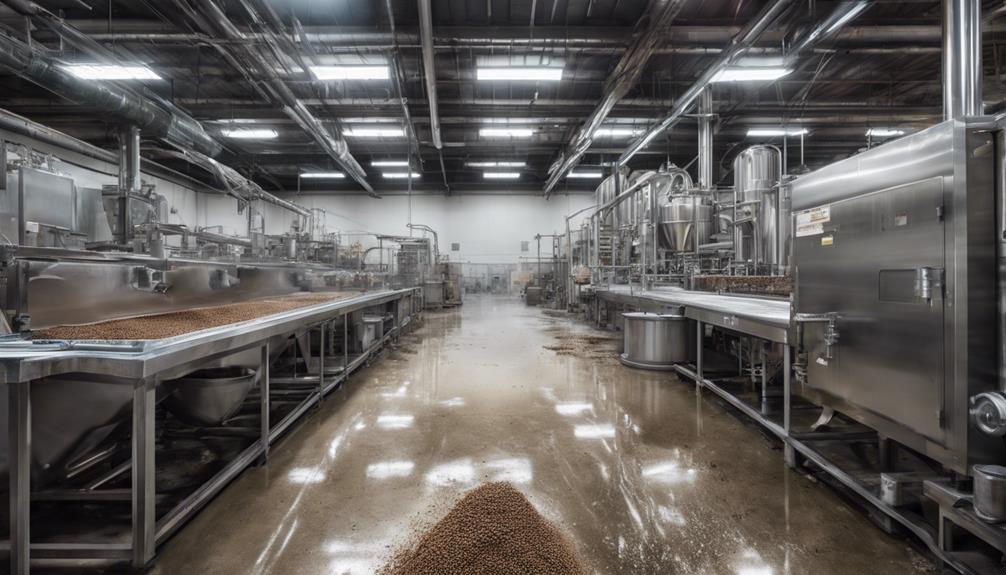
Concerns regarding contamination in the manufacturing area of OC Raw Dog Food were highlighted by the FDA's discovery of non-pathogenic bacteria during their inspection. This discovery emphasized potential risks and the need for enhanced sanitation controls to boost food safety and compliance.
Addressing non-pathogenic bacteria is essential to prevent pathogenic contamination and guarantee the overall safety of the products. Here are four key points to ponder:
- The presence of non-pathogenic bacteria, such as Listeria innocua and Listeria grayii, in the manufacturing area raised concerns about contamination risks.
- FDA's inspection at OC Raw Dog Food underscored the importance of sanitation controls to tackle safety issues.
- Understanding and managing non-pathogenic bacteria play a crucial role in maintaining compliance with food safety regulations.
- Improved sanitation measures are necessary to minimize the likelihood of pathogenic contamination, safeguarding the quality of the products and ensuring consumer health.
Redacted Recall Date Controversy
The FDA's decision to redact the recall date in the OC Raw Dog Food Warning Letter has sparked controversy within the pet food industry. This move has left many questioning the transparency of the FDA and raised concerns about a potential bias against raw pet food products. During the FDA's inspection at OC Raw Dog Food, non-pathogenic bacteria were discovered, leading to further scrutiny of how such findings were handled in the context of the recall.
To shed light on this issue, let's take a closer look at the contrasting treatment of recall dates in the FDA's Warning Letters. The inconsistency in revealing this vital information has fueled speculations about the agency's approach to regulating pet food products. The redaction of the recall date has left many in the industry perplexed and has added to the already heated debate surrounding the inspection findings.
| Key Points | Impact |
|---|---|
| Redacted Recall Date | Lack of transparency |
| Non-pathogenic Bacteria | Inspection scrutiny |
| Potential FDA Bias | Industry skepticism |
| Treatment of Raw Pet Food | Regulatory concerns |
Pet Owner Advocacy Response
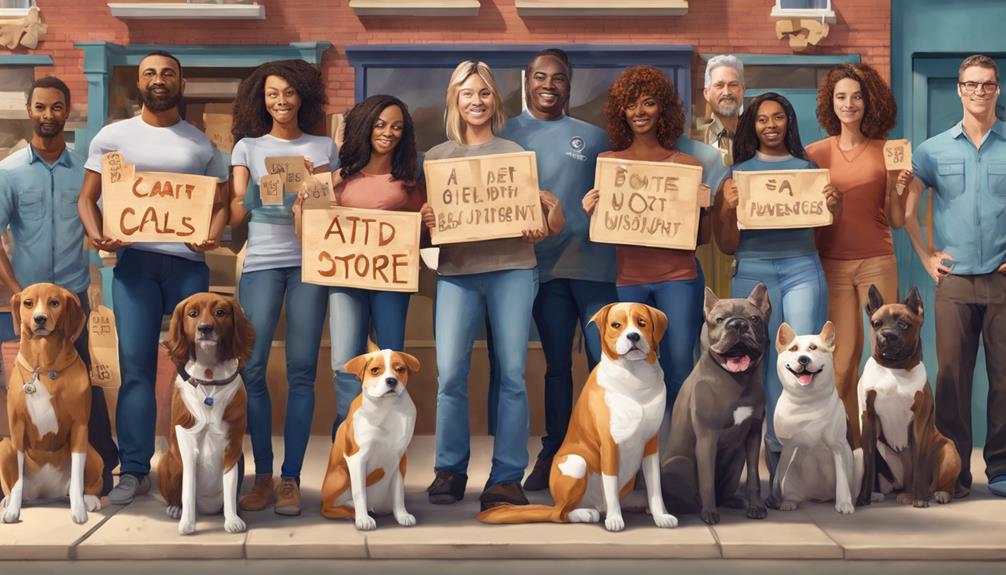
Advocating for pet owners' rights and safety, we're uniting to demand transparency and fairness from regulatory agencies like the FDA. As pet owners, it's vital that we stand together to guarantee the accountability of those responsible for overseeing pet food safety. Here are some key points to ponder in our advocacy response:
- Demanding Transparency: We seek clear and open communication from the FDA regarding their actions and decisions related to the OC Raw Dog food recall.
- Urging for Accountability: It's essential that regulatory bodies are held responsible for their oversight of the pet food industry to prevent incidents like this from happening again.
- Exploring Fair Treatment: Pet owners deserve equal treatment and fair practices when it comes to the regulation of pet food products.
- Supporting Pet Food Safety Advocates: By standing with advocacy groups, we can amplify our voices and push for necessary changes in the industry to enhance pet food safety standards.
Call for Industry Regulation
In response to recent FDA actions, industry stakeholders are increasingly calling for uniform regulation of the pet food sector. Pet owners are rightfully questioning the selective enforcement of laws by regulatory agencies like the FDA.
There's a growing need for transparency and accountability within the pet food industry to address safety issues effectively. Advocates are urging pet owners to demand vital treatment and unbiased practices from regulatory bodies.
Criticism towards the FDA for potential bias in handling pet food safety concerns highlights the significance of consistent enforcement measures. Despite these challenges, there's optimism for positive change and enhanced accountability in the regulatory landscape governing the pet food industry.
It's important for all parties involved to work together towards creating a system that prioritizes the well-being of our beloved pets and fosters trust among consumers.
Frequently Asked Questions
What Does OC Raw Stand For?
OC Raw stands for 'Original Cuisine Raw.' It reflects a commitment to natural pet food. The brand focuses on high-quality, whole ingredients and offers raw dog food products and treats that prioritize species-appropriate nutrition.
Is OC Raw Dog Food Human Grade?
No, OC Raw Dog Food is not human grade. It's designed for pets with different nutritional needs. While some ingredients may resemble human-grade food, the focus is on balanced dog nutrition, not meeting human food safety standards.
What Dog Food Has Been Recalled the Most?
The dog food recalled the most for potential health risks is OC Raw Dog's Freeze-Dried Sardines and Chicken, Fish & Produce. It's important to check UPCs and lot numbers. The recall aims to prevent botulism poisoning and Listeria contamination.
What Dog Food Is Being Recalled in 2024?
I'm recalling Freeze-Dried Sardines and Chicken, Fish & Produce products in 2024 due to Listeria monocytogenes contamination. Check UPCs and manufacturing dates for raw frozen Canine Formulation with lot #3652 and USE BY DATE of 10/11/18. No linked illnesses reported.
Conclusion
To sum up, while the raw dog food recall may seem like a minor issue, it highlights the importance of being vigilant about the products we give our pets.
It's a dog-eat-dog world out there, and we must always prioritize their health and safety.
Stay informed, stay cautious, and always trust your instincts when it comes to your furry friends' well-being. After all, they trust us to make the right choices for them.
As our Editor-in-Chief, James plays a pivotal role in ensuring the quality and integrity of our content. With a keen eye for detail and a passion for storytelling, James oversees the editorial process here at A Place for Animals. With years of experience in content editing, James ensures that every piece of content meets our high standards of accuracy and clarity. Under James’ guidance, you can rest assured that the content you read is informative and impeccably crafted.
-

 Vetted1 month ago
Vetted1 month ago15 Best Cat Foods for Managing Hyperthyroidism – Vet Approved and Feline Friendly
-

 Cats7 months ago
Cats7 months agoTop 5 Cat Breeders in Arkansas: A Guide
-

 Animal Facts1 month ago
Animal Facts1 month agoSpring Animals: A Guide to Seasonal Wildlife
-

 Vetted1 month ago
Vetted1 month ago15 Best Fresh Dog Food Delivery Services for Your Pup's Health and Happiness
-

 Rabbits2 months ago
Rabbits2 months agoExploring Rabbit Holes: What Do They Look Like?
-
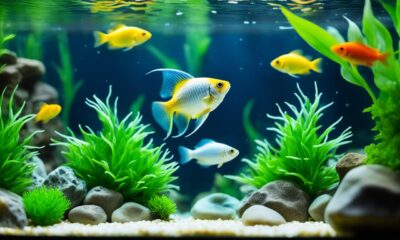
 Fish2 months ago
Fish2 months agoKeeping Your Sucker Fish Thriving at Home
-

 Pets2 months ago
Pets2 months agoLatest Pet Statistics in US – Trends & Insights in 2024
-

 Vetted1 month ago
Vetted1 month ago15 Best Dog Foods for Kidney Disease – Expert Recommendations for Your Pet's Health



















